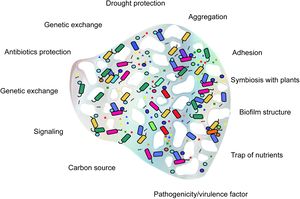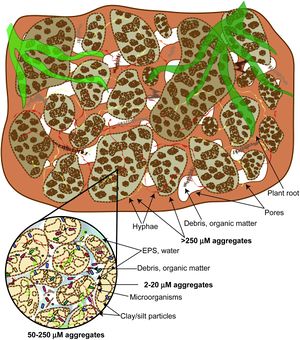Extracellular polymeric substance: Difference between revisions
No edit summary |
mNo edit summary |
||
| Line 2: | Line 2: | ||
<!-- PLEASE IGNORE THE CITATIONS I am tryin to fix them to work like they are supposed to so in the mean time they look like this mess--> | <!-- PLEASE IGNORE THE CITATIONS I am tryin to fix them to work like they are supposed to so in the mean time they look like this mess--> | ||
[[File:Mixed-culture biofilm.jpg|thumb|right|EPS binding soil particles taken by an election scanning microscope. | [[File:Mixed-culture biofilm.jpg|thumb|right|EPS binding soil particles taken by an election scanning microscope.<ref>Aalexopo, https://commons.wikimedia.org/wiki/File:Biofilm_Formation.jpg.CC BY-SA 3.0</ref> The spherical and tube shapes are soil micorbes and the connecting structure is made out of EPS]] | ||
= Overview = | = Overview = | ||
[[File:fmicb-09-01636-g001.jpg|thumb|right|theoretical functions of soil EPS<ref name=Costa_2018 />]] | [[File:fmicb-09-01636-g001.jpg|thumb|right|theoretical functions of soil EPS<ref name=Costa_2018 />]] | ||
Revision as of 10:12, 6 May 2021

Overview

Extracellular polymeric substances (EPS) are a group of substances exuded by microorganisms in order to form biofilms. The major components are extracellular polysaccharides (sometimes also called EPS), proteins, DNA, enzymes, lipids, and other biopolymers[3]. EPS accounts for 90% of biofilm dry mass and constitutes the matrix of the biofilm[3]. Biofilms are micro-habitats that keep microbes attached to a substrate[4], provide protection from desiccation[5][6], and play a key role in nutrient cycling[7]. EPS is known to alter the structure [4][8], hydrology [6][9][10][11], and composition [8][12][2] of soils. It is important in aggregate formation and acts as an interface between soil and plant interactions with microbes. At the soil interface EPS facilitates chemical reactions and transportation of nutrients. At the plant interface EPS acts as the exchange media through which plant exudates and microbial secretions can be exchanged.
Functions

Habitat stability
The suspected primary role of EPS is to create stable habitat bound to a desired substrate[]. EPS is the matrix structure of biofilms. Biofilms are very effective at retaining water in soils even with very negative water potentials.[] This allows microbes to resist desiccation during drought periods. EPS can also stabilize pH and reduce the amount of nutrients lost to runoff by binding to them.
Chemical reactions
EPS provides a stable interface for soil microbes to chemically work on attached substrate and suspended materials. In addition EPS itself is a store of carbon and other nutrients. The binding nature of EPS also helps reduce nutrient loss in soils from runoff.[]
Hydrology
EPS resists evaporation by binding the water tightly[]. The biofilms formed with EPS can cause bioclogging of pores which resists evaporation and mass flow of water by reducing the hydraulic conductivity[]. This slows the rate of change in soil moisture content.
Soil Structures
EPS production fills soil pore space which reduces the effective average pore size[]. For the potential impacts of this see [porosity]. Also, the swelling shrinking actions of EPS water intake and loss can alter the pore space but there remains a lack of literature differentiating this effect in bulk soil[]. EPS plays a key role in soil aggregate formation by working as a cementing agent. This has the added effect of reducing soil slaking and increasing overall stability. This added stability can lower erosion rates and decrease nutrient runoff.
Plants
EPS can help microbes hold onto roots or in the rhizosphere and act as the medium for free living diazotrophs and other moderately symbiotic microbes to exchange nutrients in exchange for root exudates[]. There is also evidence to suggest EPS assists in salinity tolerance for some plants.[13]
Agriculture
There is growing interest in using EPS producing bacteria because they improve soil particle aggregation which improves agricultural soil health.[2]
Analysis methods
Cation exchange resin (CER) is currently considered the best method for accurately extracting EPS from soils.[14]
References
- ↑ Aalexopo, https://commons.wikimedia.org/wiki/File:Biofilm_Formation.jpg.CC BY-SA 3.0
- ↑ 2.0 2.1 2.2 Costa, O.Y.A., Raaijmakers, J.M., Kuramae, E.E., 2018. Microbial Extracellular Polymeric Substances: Ecological Function and Impact on Soil Aggregation. Front. Microbiol. 9, 1636. https://doi.org/10.3389/fmicb.2018.01636
- ↑ 3.0 3.1 Flemming, H.-C., Wingender, J., 2010. The biofilm matrix. Nat Rev Microbiol 8, 623–633. https://doi.org/10.1038/nrmicro2415
- ↑ 4.0 4.1 Azeredo, J., Oliveira, R., 2000. The role of exopolymers in the attachment of sphingomonas paucimobilis. Biofouling 16, 59–67. https://doi.org/10.1080/08927010009378430
- ↑ Tamaru, Y., Takani, Y., Yoshida, T., Sakamoto, T., 2005. Crucial Role of Extracellular Polysaccharides in Desiccation and Freezing Tolerance in the Terrestrial Cyanobacterium Nostoc commune. AEM 71, 7327–7333. https://doi.org/10.1128/AEM.71.11.7327-7333.2005
- ↑ 6.0 6.1 Roberson, E.B., Firestone, M.K., 1992. Relationship between Desiccation and Exopolysaccharide Production in a Soil Pseudomonas sp. Applied and Environmental Microbiology 58, 1284–1291. https://doi.org/10.1128/AEM.58.4.1284-1291.1992
- ↑ Flemming, H.-C., Wingender, J., Szewzyk, U., Steinberg, P., Rice, S.A., Kjelleberg, S., 2016. Biofilms: an emergent form of bacterial life. Nat Rev Microbiol 14, 563–575. https://doi.org/10.1038/nrmicro.2016.94
- ↑ 8.0 8.1 Mager, D.M., Thomas, A.D., 2011. Extracellular polysaccharides from cyanobacterial soil crusts: A review of their role in dryland soil processes. Journal of Arid Environments 75, 91–97. https://doi.org/10.1016/j.jaridenv.2010.10.001
- ↑ Morales, V.L., Parlange, J.-Y., Steenhuis, T.S., 2010. Are preferential flow paths perpetuated by microbial activity in the soil matrix? A review. Journal of Hydrology 393, 29–36. https://doi.org/10.1016/j.jhydrol.2009.12.048
- ↑ r, D., Phutane, S., Dechesne, A., 2007. Extracellular Polymeric Substances Affecting Pore-Scale Hydrologic Conditions for Bacterial Activity in Unsaturated Soils. Vadose Zone Journal 6, 298–305. https://doi.org/10.2136/vzj2006.0080
- ↑ Deng, J., Orner, E.P., Chau, J.F., Anderson, E.M., Kadilak, A.L., Rubinstein, R.L., Bouchillon, G.M., Goodwin, R.A., Gage, D.J., Shor, L.M., 2015. Synergistic effects of soil microstructure and bacterial EPS on drying rate
- ↑ Gunina, A., Kuzyakov, Y., 2015. Sugars in soil and sweets for microorganisms: Review of origin, content, composition and fate. Soil Biology and Biochemistry 90, 87–100. https://doi.org/10.1016/j.soilbio.2015.07.021
- ↑ Ashraf, M., Hasnain, S., Berge, O., Mahmood, T., 2004. Inoculating wheat seedlings with exopolysaccharide-producing bacteria restricts sodium uptake and stimulates plant growth under salt stress. Biol Fertil Soils 40. https://doi.org/10.1007/s00374-004-0766-y
- ↑ Redmile-Gordon, M.A., Brookes, P.C., Evershed, R.P., Goulding, K.W.T., Hirsch, P.R., 2014. Measuring the soil-microbial interface: Extraction of extracellular polymeric substances (EPS) from soil biofilms. Soil Biology and Biochemistry 72, 163–171.